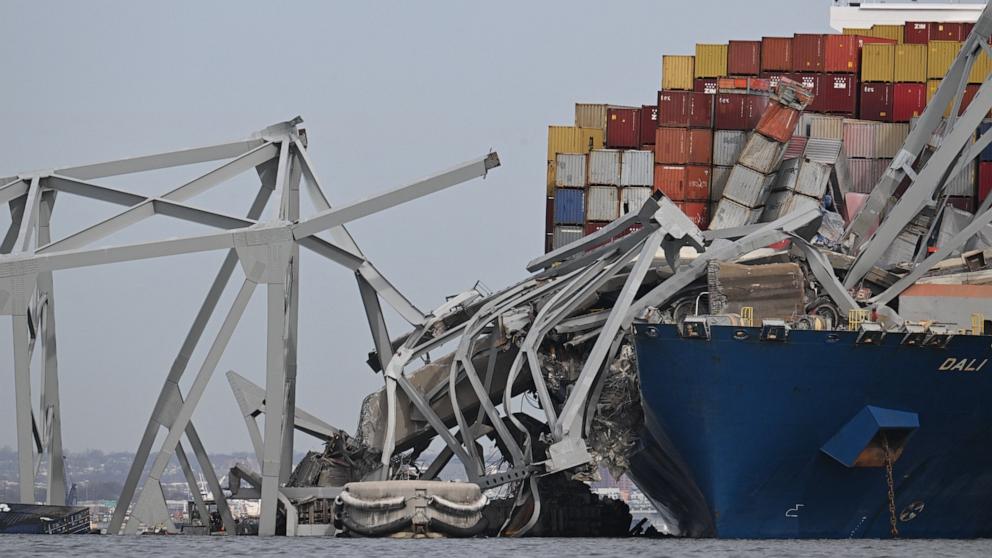 |
| Jim Watson/AFP via Getty Images |
A cargo ship crashed into Baltimore's Francis Scott Key Bridge early Tuesday morning, causing a near-total collapse of the span and halting vessel traffic into and out of the Port of Baltimore.
Six construction workers are believed to have fallen from the collapsing bridge into the frigid waters of the Patapsco River below. The bodies of two of the victims have been recovered so far, while four remain missing and are presumed dead, officials said.
Latest headlines:
- 2,600 Carnival cruise passengers rerouted from Baltimore arrive in Virginia
- 200-ton piece of collapsed Key Bridge removed
- Still no timeline on when Baltimore port will reopen: Buttigieg
- 1st portions of the collapsed Francis Scott Key Bridge will be lifted Saturday
- 3 crane barges from US Navy arrive in Baltimore, 4th coming next week
- Freight nearly size of Eiffel Tower, shipping containers 'ripped in half as if they were papier-maché'
The container ship Dali struck Baltimore's Francis Scott Key Bridge at about 1:30 a.m. Tuesday, partially collapsing the bridge, officials in Maryland said.
A local pilot was at the helm of the ship at the time, Maryland Department of Transportation Secretary Paul Wiedefeld said.
The crash appeared to be accidental, not intentional, officials said.
Two construction workers were rescued and six went missing in the immediate aftermath of the collapse, officials said. The bodies of two of the victims were recovered from the water on Wednesday amid ongoing search and recovery efforts, while four remain missing and are presumed dead, officials said.
The Captain of the Port of Baltimore (COTP) is preparing to establish a temporary alternate channel on the northeast side of the main channel in the vicinity of the Francis Scott Key Bridge for commercially essential vessels.
"This will mark an important first step along the road to reopening the port of Baltimore," said Capt. David O’Connell, federal on-scene coordinator, Key Bridge Response 2024. "By opening this alternate route, we will support the flow of marine traffic into Baltimore."
This action is part of a phased approach to opening the main channel. The temporary channel will be marked with government lighted aids to navigate and will have a controlling depth of 11 feet, a 264-foot horizontal clearance, and vertical clearance of 96 feet.
The current 2,000-yard safety zone around the Francis Scott Key Bridge remains in effect and is intended to protect personnel, vessels and the marine environment. No vessel or person will be permitted to enter the safety zone without obtaining permission from the COTP or a designated representative.
The COTP will issue a Broadcast Notice to Mariners (BNM) via VHF-FM marine channel 16. Mariners are requested to monitor VHF channel 16 for the latest information.
Members of the public may not enter the safety zone unless authorized by the COTP or a designated representative. Those in the safety zone must comply with all lawful orders or directions given to them by the COTP or a designated representative.
The first of multiple Carnival cruise ships rerouted from Baltimore due to the collapse of the Francis Scott Key Bridge arrived at a port in Norfolk, Virginia, on Sunday
About 2,600 guests aboard the Carnival Legend returned from a cruise to the Bahamas, getting off the ship in Norfolk. The passengers boarded 70 buses and were driven four hours back to Baltimore, where many left their cars parked.
"When we left Baltimore, we had to go under that bridge," passenger Viktoriia Aldred told ABC affiliate station WVEC in Norfolk. "The bridge looked amazing and you go under the bridge and you're like 'wow.'"
Baltimore native Michael Lukoski told WVEC he heard the news of the bridge collapse while on the cruise to the Bahamas.
"When I got the news Tuesday morning … you couldn’t believe it," said Lukoski. adding that when he first heard of the bridge collapse "it was like, 'no way.'"



0 Comments